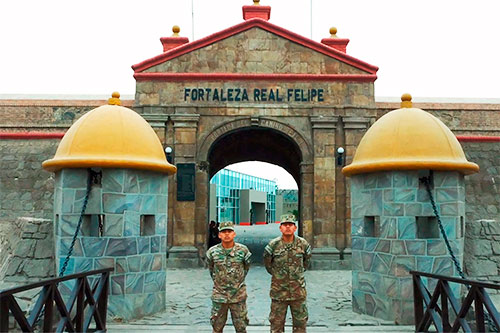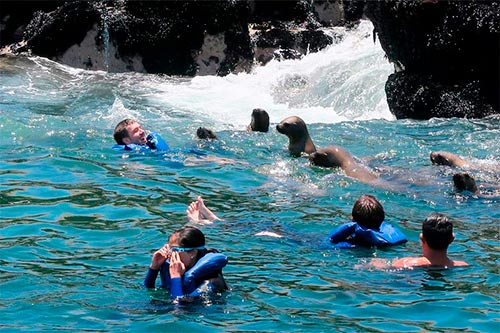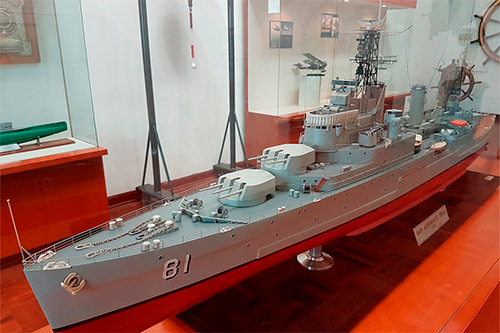Callao, the first port of Peru
Callao is a port city neighboring Lima. Due to the important historical events that took place there, it holds the honorary title of ‘constitutional province’. Its main tourist attractions are the Real Felipe fortress, the Palomino islands, the faces of Atahualpa and the joy of its people. There you can enjoy a fresh ceviche, a refreshing summer and a good sauce. Know in detail its attractions, its history, prices, advice and more.
All about Callao
Explore Callao

1 The fortress of Real Felipe
The Real Felipe fortress is in Callao, about 14 kilometers from the center of Lima. It was the most important military construction of the Viceroyalty of Peru.

2 The Palomino islands in Callao
Boats depart from Square Grau del Callao to the islands of San Lorenzo, El Frontón, Cavinza and Palomino where you can swim with sea lions.

3 The Callao naval museum
The museum shows the history of the Peruvian Navy, from the beginnings of pre-Hispanic Peru until today, through the War with Chile.
The first port of Peru
Callao is considered the first port of Peru. It is that from the viceregal era until today, there are exported and imported products to all parts of the planet. Even in the Spanish colony it was the main port on the entire western Pacific coast.
Callao, con 1 millón de habitantes aproximadamente, es la tercera ciudad más poblada del Perú, después de Lima y the white city of Arequipa. It stands out because there is the Jorge Chávez international airport, the main one in the country.
Callao is witness to some of the most important historical events in Peru. From its beginnings it was invaded by pirates. News from Europe arrived through its port, such as football. Today it is a modern place, full of factories, restaurants, tourist attractions but unfortunately in certain districts also with high crime rates.
There are many reasons to visit Callao. Its main tourist attractions are the Real Felipe fortress, the Palomino islands, the faces of Atahualpa, the Chucuito neighborhood and the beautiful La Punta spa..
Other good reasons to visit this historic place are its beaches, its delicious seafood cuisine, its shopping centers and, above all, the joy and warmth of its people.
Location and districts
El Callao is located on the central coast of Peru, about 13 kilometers from the city of Lima. It is located at sea level, in an area of approximately 148 square kilometers.
The province of Callao has seven districts: Bellavista, Carmen de la Legua, La Perla, La Punta and Ventanilla and the district of Mi Peru. It also has a coastline with four islands: San Lorenzo, El Frontón, Cavinzas, Palomino and the Redondo islet.
How to get there from Lima?
To get to Callao from the city of Lima you must follow the following steps:
- From any part of the city of Lima you must take a public transport bus to Plaza 2 de Mayo in the historic center of the city. A good option is to take the “Metropolitan” service for a cost of approximately 2 soles 50 cents.
- From Plaza 2 de Mayo you can take any public transport service to Callao. You can also choose a taxi or jeepney service. The cost varies depending on the service you choose. A taxi can cost between 10 to 20 Peruvian soles.
- A good option is to go to Plaza Miguel Grau, from where you can visit tourist attractions such as the Real Felipe fortress or the Palomino Islands.
Callao Map
History
The history of Callao goes back thousands of years. Throughout its territory there are traces of ancient Peruvian cultures such as the Lima culture, the Ychma culture or the Maranga curacazgo. However, the formation of Callao as it is known today began with the arrival of the Spanish in the 16th century. The Europeans took advantage of its good location to create the main port of the Viceroyalty of Peru.
Unlike Lima, there is no founding act for Callao. However, since 1536 the works and operations began to make it the first port of Lima and the Spanish colony in America. This attracted the greed of several pirates who attacked the port (in 1579 it was stormed by the famous English corsair Francis Drake). Because of this, the Spanish authorities decided to build the Real Felipe fortress in 1747, a work that lasts until today. This construction defended Peru during the historic ‘Combate of May 2’ in 1866.
The 1746 earthquake damaged many structures in the port and the Real Felipe fortress. After this, more port and urban buildings are carried out. In 1857 it was declared the ‘Constitutional Province of Peru’, an honorary title that highlights its importance and history. In the 19th century, the heyday of guano, brought with it an economic development that helped build the Lima-Callao railway, houses on Constitución street, Castilla street, Libertad street as well as Matriz square and Grau square. At the end of that century, the novelties of Europe arrived in the country through the ‘chalaco’ port.
Today Callao is the third most populated city in Peru (approximately 1 million inhabitants). It also has a modern infrastructure where factories, shopping centers, markets, stadiums and the main international airport of Peru are concentrated. Every day a significant number of people (the majority from Lima) arrive there for work and tourist reasons. Unfortunately crime is a problem that still cannot be solved. However, its main tourist attractions have police surveillance. There are many good reasons to visit this historic part of the country.
Tourist attractions
- Real Felipe Fortress – Military fortification built in the 18th century, during the time of the Viceroyalty of Peru. Its function was to protect the port of Callao from pirate attacks. It served as a defense for the Peruvian army during the combat of May 2 in 1866. Today it is a museum and historical site open to visitors.
- Palomino Islands – Group of islands located in the bay of Callao that are home to diverse wildlife such as sea lions, Humboldt penguins and various species of seabirds. The islands most visited by tourists are: Cavinzas, San Lorenzo, El Frontón and Palomino. The tourist tours that include a boat, lifeguard equipment and the possibility of swimming with sea lions depart from Plaza Miguel Grau.
- The faces of Atahualpa – In the popular Atahualpa neighborhood (square 8 of Miró Quesada avenue) is this famous mural where the faces of artistic characters (especially music) identified with the popular culture of Callao have been drawn. They stand out: Héctor Lavoe, Frankie Ruiz, Celia Cruz, Cheo Feliciano and more. Little by little, people from Lima began to arrive seeking to be photographed on this wall, which turned it into an urban tourist attraction.
- The Chucuito neighborhood – The tradition and history of Callao are present in this popular ‘chalaco’ neighborhood. Chucuito was one of the first fishermen’s neighborhoods and it has maintained the style of its Gothic-style houses built by Italian immigrants between approximately 1900 and 1920. Being photographed on the facades of these colorful houses attracted the attention of tourists, mainly from the city of Lima.
- La Punta spa – As its name indicates, this district is a ‘point’ or peninsula that juts out into the sea. It was one of the first urban areas of Callao. He witnessed pirate attacks, the May 2 Combat, the War with Chile and more. Today it stands out for its beautiful boardwalks facing the sea as well as its graffiti and murals that highlight its history and popular culture.
Hotels and restaurants in Callao
Callao has a good hotel offer. Most of the 4-star services are located in the vicinity of the Jorge Chávez International Airport. Highlights: the Costa del Sol Wyndham Lima Airport hotel and the Holiday Inn – Lima Airport an IHG Hotel. Other 3-star hotels also stand out, such as: Hotel Ayenda B&B Wasi Airport Lima, Hotel Padama, Hospedaje el viajero – airport and more.
In the case of restaurants, it is necessary to mention the quality of their seafood dishes such as cebiche, rice with seafood, chilcano and more. The most popular and recommended restaurants are: El Bistró (seafood), El comedor (seafood), La Caleta (seafood), Taller Razeto (Italian food), Don Giuseppe (fusion Marian food) and El Mirador (seafood). Most of the restaurants are in the La Punta district.
Beaches
Callao has more than 30 kilometers of coastline, from the district of La Punta to the district of Ventanilla. These are mainly visited by the local population, although there are also bathers from Lima. The most visited beaches are: La Punta beach, Gulligan beach, Arenilla beach, Carpayo beach, Chucuito beach, Grau beach, Oquendo beach, Chillón beach, Márquez beach and Ventanilla beach.
It is dangerous?
Callao has one of the highest crime rates in Peru. However, these indices are registered in certain areas of Bellavista, La Perla, Carmen de la Legua Reynoso and Ventanilla. The district of La Punta and Callao, where the main tourist attractions are, are places with greater police surveillance and, consequently, security.
Climate
Callao has a humid coastal climate due to its proximity to the sea. The highest temperatures that can reach 28ºC are recorded in the months of January, February and March. The months of May, June and July are the coldest with temperatures that can drop to 13ºC. It is a pleasant climate for the visitor.
Photos of Callao
Questions and answers
- 1) Where to eat cheap in Callao?
The central market of Callao, located at Jirón Colón 555, offers the best of Peruvian gastronomy (especially seafood) at affordable prices. - 2) How to get from Miraflores to Callao?
In the Miraflores oval you can get public transport that runs along the entire La Marina avenue and Faucett avenue until you arrive at the airport. From there you can get a taxi or other public transport to visit the rest of the district. - 3) What to bring on my visit?
Take with you the necessary things such as a hat, sunscreen, comfortable clothes, cash and your identity documents. It is not advisable to bring valuable items such as gold watches or high-end cell phones. - 4) How much does a tour to the Palomino Islands cost?
The price of a tour of the Palomino Islands is 120 soles per tourist on average. - 5) Why are many walls in Callao painted pink?
Most of the residents of Callao are fans of the Sport Boys soccer club whose uniform is pink. - 6) How much does the entrance to the Real Felipe fortress cost?
The entrance to this historic fortress is 15 Peruvian soles for foreign adults and 10 soles for Peruvian adults. - 7) Where to get tours to Callao?
In the Miguel Grau square, the main square in the city, you can get the main tours to the Palomino islands, the Real Felipe fortress or other tourist destinations. - 8) What other tourist attractions can I visit?
In addition to the Real Felipe fortress, the Palomino islands or the faces of Atahualpa, you can visit the Abtao underwater museum, the Naval Museum of Peru, the main church of Callao or the Cantolao spa.